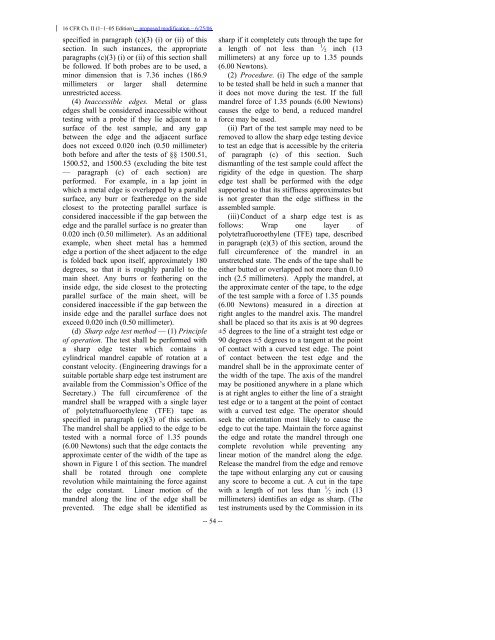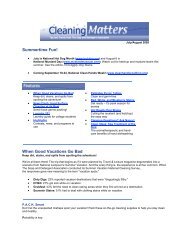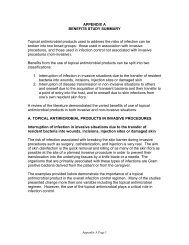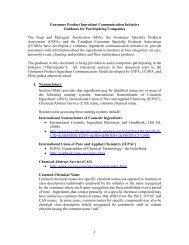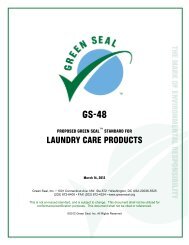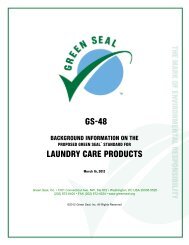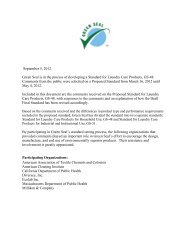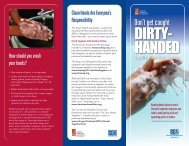subchapter c -- federal hazardous substances act regulations
subchapter c -- federal hazardous substances act regulations
subchapter c -- federal hazardous substances act regulations
You also want an ePaper? Increase the reach of your titles
YUMPU automatically turns print PDFs into web optimized ePapers that Google loves.
16 CFR Ch. II (1–1–05 Edition) – proposed modification – 6/25/06<br />
specified in paragraph (c)(3) (i) or (ii) of this<br />
section. In such instances, the appropriate<br />
paragraphs (c)(3) (i) or (ii) of this section shall<br />
be followed. If both probes are to be used, a<br />
minor dimension that is 7.36 inches (186.9<br />
millimeters or larger shall determine<br />
unrestricted access.<br />
(4) Inaccessible edges. Metal or glass<br />
edges shall be considered inaccessible without<br />
testing with a probe if they lie adjacent to a<br />
surface of the test sample, and any gap<br />
between the edge and the adjacent surface<br />
does not exceed 0.020 inch (0.50 millimeter)<br />
both before and after the tests of §§ 1500.51,<br />
1500.52, and 1500.53 (excluding the bite test<br />
— paragraph (c) of each section) are<br />
performed. For example, in a lap joint in<br />
which a metal edge is overlapped by a parallel<br />
surface, any burr or featheredge on the side<br />
closest to the protecting parallel surface is<br />
considered inaccessible if the gap between the<br />
edge and the parallel surface is no greater than<br />
0.020 inch (0.50 millimeter). As an additional<br />
example, when sheet metal has a hemmed<br />
edge a portion of the sheet adjacent to the edge<br />
is folded back upon itself, approximately 180<br />
degrees, so that it is roughly parallel to the<br />
main sheet. Any burrs or feathering on the<br />
inside edge, the side closest to the protecting<br />
parallel surface of the main sheet, will be<br />
considered inaccessible if the gap between the<br />
inside edge and the parallel surface does not<br />
exceed 0.020 inch (0.50 millimeter).<br />
(d) Sharp edge test method — (1) Principle<br />
of operation. The test shall be performed with<br />
a sharp edge tester which contains a<br />
cylindrical mandrel capable of rotation at a<br />
constant velocity. (Engineering drawings for a<br />
suitable portable sharp edge test instrument are<br />
available from the Commission’s Office of the<br />
Secretary.) The full circumference of the<br />
mandrel shall be wrapped with a single layer<br />
of polytetrafluoroethylene (TFE) tape as<br />
specified in paragraph (e)(3) of this section.<br />
The mandrel shall be applied to the edge to be<br />
tested with a normal force of 1.35 pounds<br />
(6.00 Newtons) such that the edge cont<strong>act</strong>s the<br />
approximate center of the width of the tape as<br />
shown in Figure 1 of this section. The mandrel<br />
shall be rotated through one complete<br />
revolution while maintaining the force against<br />
the edge constant. Linear motion of the<br />
mandrel along the line of the edge shall be<br />
prevented. The edge shall be identified as<br />
-- 54 --<br />
sharp if it completely cuts through the tape for<br />
a length of not less than<br />
1 ⁄ 2 inch (13<br />
millimeters) at any force up to 1.35 pounds<br />
(6.00 Newtons).<br />
(2) Procedure. (i) The edge of the sample<br />
to be tested shall be held in such a manner that<br />
it does not move during the test. If the full<br />
mandrel force of 1.35 pounds (6.00 Newtons)<br />
causes the edge to bend, a reduced mandrel<br />
force may be used.<br />
(ii) Part of the test sample may need to be<br />
removed to allow the sharp edge testing device<br />
to test an edge that is accessible by the criteria<br />
of paragraph (c) of this section. Such<br />
dismantling of the test sample could affect the<br />
rigidity of the edge in question. The sharp<br />
edge test shall be performed with the edge<br />
supported so that its stiffness approximates but<br />
is not greater than the edge stiffness in the<br />
assembled sample.<br />
(iii) Conduct of a sharp edge test is as<br />
follows: Wrap one layer of<br />
polytetrafluoroethylene (TFE) tape, described<br />
in paragraph (e)(3) of this section, around the<br />
full circumference of the mandrel in an<br />
unstretched state. The ends of the tape shall be<br />
either butted or overlapped not more than 0.10<br />
inch (2.5 millimeters). Apply the mandrel, at<br />
the approximate center of the tape, to the edge<br />
of the test sample with a force of 1.35 pounds<br />
(6.00 Newtons) measured in a direction at<br />
right angles to the mandrel axis. The mandrel<br />
shall be placed so that its axis is at 90 degrees<br />
±5 degrees to the line of a straight test edge or<br />
90 degrees ±5 degrees to a tangent at the point<br />
of cont<strong>act</strong> with a curved test edge. The point<br />
of cont<strong>act</strong> between the test edge and the<br />
mandrel shall be in the approximate center of<br />
the width of the tape. The axis of the mandrel<br />
may be positioned anywhere in a plane which<br />
is at right angles to either the line of a straight<br />
test edge or to a tangent at the point of cont<strong>act</strong><br />
with a curved test edge. The operator should<br />
seek the orientation most likely to cause the<br />
edge to cut the tape. Maintain the force against<br />
the edge and rotate the mandrel through one<br />
complete revolution while preventing any<br />
linear motion of the mandrel along the edge.<br />
Release the mandrel from the edge and remove<br />
the tape without enlarging any cut or causing<br />
any score to become a cut. A cut in the tape<br />
with a length of not less than 1 ⁄ 2 inch (13<br />
millimeters) identifies an edge as sharp. (The<br />
test instruments used by the Commission in its


